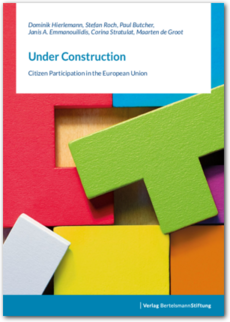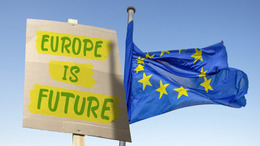As in any democracy, it is of vital importance for the European Union (EU) that citizens are able to participate in political decision-making in a variety of ways. The Conference on the Future of Europe currently drawing to a close is intended to amplify EU citizens’ voices. Yet the overall framework for European-level participation today is far from robust. A new study we jointly published with the European Policy Centre finds that the EU in fact offers a patchwork of citizen participation instruments. Most European citizens are unaware of these instruments or know little about them. Only 15% of European Union citizens say it is easy for them to participate in EU politics. The EU lacks a comprehensive participation infrastructure. "In order to improve citizen participation, the EU needs to build a participation infrastructure. To be perceived as legitimate, democracy in the EU needs more than just elections every five years. It is important that European citizens be able to participate more visibly, effectively and continuously in specific European policymaking processes," said our expert on citizen participation Dominik Hierlemann.
![[Translate to English:] Eine Frau hält die Publikation "Under Construction" in ihren Händen. Im Hintergrund ist ein kleines Fähnchen der Europäischen Union zu sehen.](/fileadmin/files/_processed_/4/b/csm_946325177220407_besimmazhiqi-49_aecaea95f6.jpg)
Besim Mazhiqi
Europe lacks a functioning infrastructure for its citizens’ political participation
Our new study "Under Construction: Citizen Participation in the EU" shows that the EU has numerous instruments for citizen participation in place. However, the general public is not well aware of these mechanisms, and their impact is often quite limited. The individual instruments do not add up to a visible, comprehensive and effective participation infrastructure in Europe. Citizen participation in European decision-making processes consequently takes place via a patchwork of participatory instruments. In the study, we offer five recommendations for constructing a better participation infrastructure.
Content
Three gaps in European citizen participation
Drawing on an analysis of seven EU participation instruments, the study concludes that it would be possible to develop a coherent EU participation infrastructure. To achieve this, three gaps in the existing EU participation patchwork would need to be filled.
1. The awareness gap
In an eupinions survey conducted as part of this study, four out of five respondents said they thought citizens should have a bigger say in EU decision-making. But only a minority (46%) believes that their voices count in European politics. Only 15% of respondents said they found it easy to participate in politics at the European level, compared to 25% at the national level and a much higher 46% at the local level. The analysis indicates that this is not primarily because existing EU participation instruments are difficult to use. Rather, they are simply not well-known among European citizens. The elections to the European Parliament are the single exception in this regard.
2. The performance gap
Most existing participation instruments offer considerable room for improvement. Not only are they largely unknown; they also have relatively little political influence on European policymaking. Only a quarter of the European democracy experts interviewed for the study said the instruments function as they should. Citizens are often left in the dark as to what happens to their input. It therefore comes as little surprise that Europeans feel that they have little ability to influence EU decisions.
3. The political commitment gap
Fewer than one in five (17%) of the EU democracy experts surveyed for the study said they believed the EU successfully facilitates citizen participation at the European level. There is a gap between the EU rhetoric of a "Europe of citizens" and the actual practice of EU citizen participation. Levels of understanding and knowledge regarding existing participation instruments are low – certainly among citizens, but also among political insiders. The push for more participation is typically driven by a small circle of participation enthusiasts within the EU’s institutions, and draws little support from the broader political establishment.
In order to improve citizen participation, the EU needs to build a participation infrastructure. To be perceived as legitimate, democracy in the EU needs more than just elections every five years.
Dominik Hierlemann, expert on citizen participation at the Bertelsmann Stiftung
Five recommendations for building a participation infrastructure
1. Cultural change
Citizen participation must become an integral feature of EU democracy, rather than simply being a “nice to have” element in Brussels and the national capitals. In the eupinions survey, 78% of respondents agreed that citizens should have a bigger say in European decision-making. The EU and its member states should respond to this wish. However, one of the main problems is that the EU currently lacks a common understanding of the nature, potential and different formats of citizen participation.
2. Strategy
The EU’s institutions and the member states must develop and agree upon a common strategy. This will require a common vision and a shared understanding of the meaning, purpose and benefits of the European Union’s participation infrastructure. The study identifies a number of criteria for good participation, including visibility, accessibility, representativeness, transnationality, deliberativeness and impact.
3. More visibility for EU participation instruments
Joint communication efforts are needed to make the participation infrastructure visible to the general public. Citizens across Europe need to know more about how they can get involved in European policymaking. The eupinions survey results clearly indicate that citizens today have only a vague idea of their participation rights. For example, only about 19% of respondents were able to identify the European Citizens’ Initiative (ECI) as an EU participation instrument. Fully 95% of the democracy experts we surveyed for this study said they did not believe the existing participation instruments were sufficiently known and used.
4. A central online hub for EU citizen participation
An EU participation infrastructure needs a central, user-friendly and clearly explained online platform for all of its participation instruments. A hub of this kind could provide networking opportunities, facilitate effective communication and offer civic education on the issue of EU citizen participation. According to the eupinions survey, an overwhelming majority of citizens in Europe (71%) find it difficult to participate at the EU level.
5. Digital potential and new participation formats
Modern citizen participation also needs stronger digital components. Digital mechanisms can increase the visibility and effectiveness of existing instruments by allowing them to reach new audiences. In addition, new formats should be used more often and institutionalized. In the context of the Conference on the Future of Europe, for example, randomly selected people from all across Europe participated on citizen panels.
In the absence of a comprehensive reform of citizen participation at the European level, these instruments will continue to have a patchwork nature. This could lead to a situation in which citizens take less and less interest in European politics over time, expanding the gap between policymakers and citizens. "To protect and strengthen liberal democracy at the EU level, we must enable more and better participation," said Janis A. Emmanouilidis, deputy director and director of studies at the Brussels-based European Policy Centre.
Materials
Additional information
The "Under Construction: Citizen Participation in the European Union" study was conducted jointly by our foundation and the European Policy Centre. It analyses seven EU participation instruments, including elections to the European Parliament, the European Citizen’s Initiative, Petitions to the European Parliament, the European Ombudsman, Public Consultations, the Citizens’ Dialogues and the European Citizens’ Consultations. The study’s approach uses several methods of investigation, including semi-structured interviews and a survey of nearly 100 political decision-makers and EU democracy experts, a representative EU population survey conducted by eupinions (performed between March 5 and March 25, 2020, with a total of 11,467 respondents across Europe), and relevant literature.









